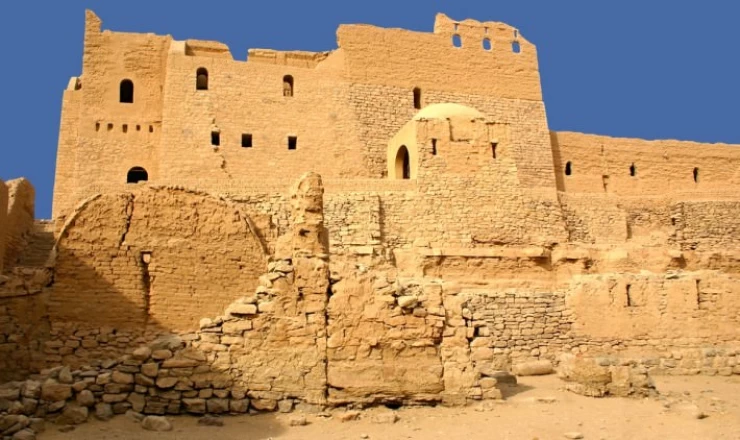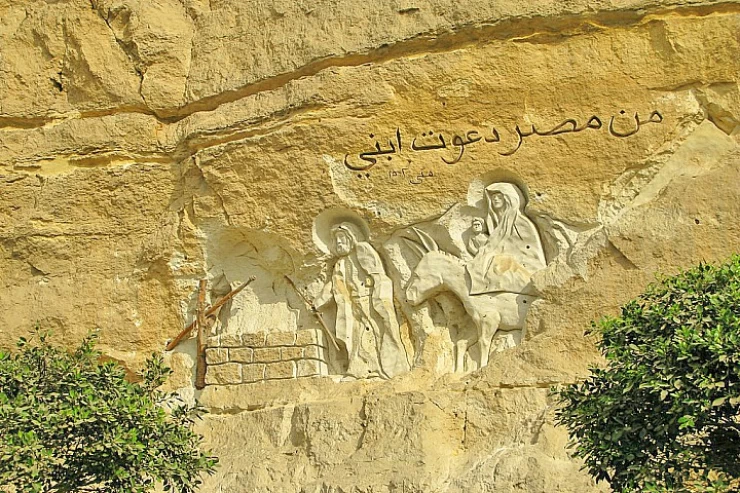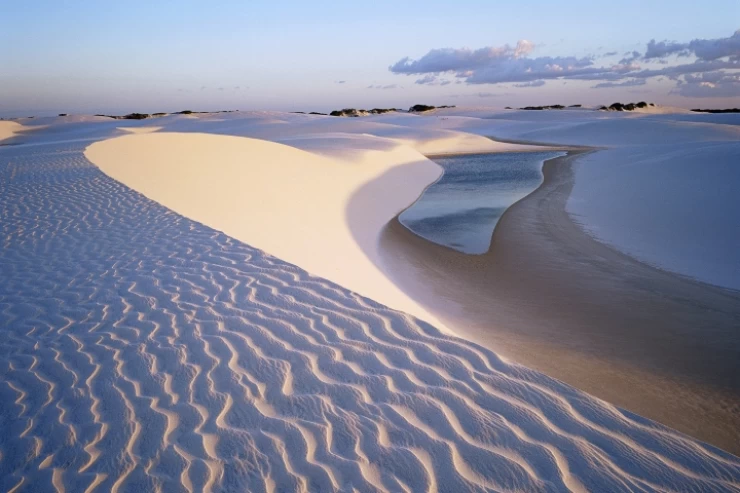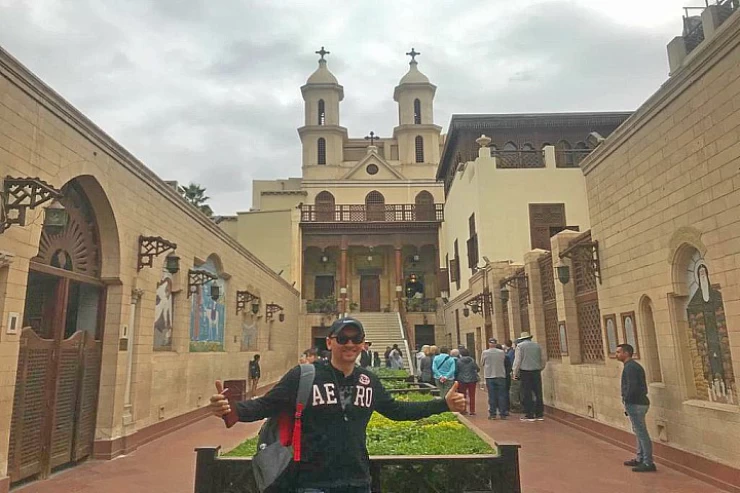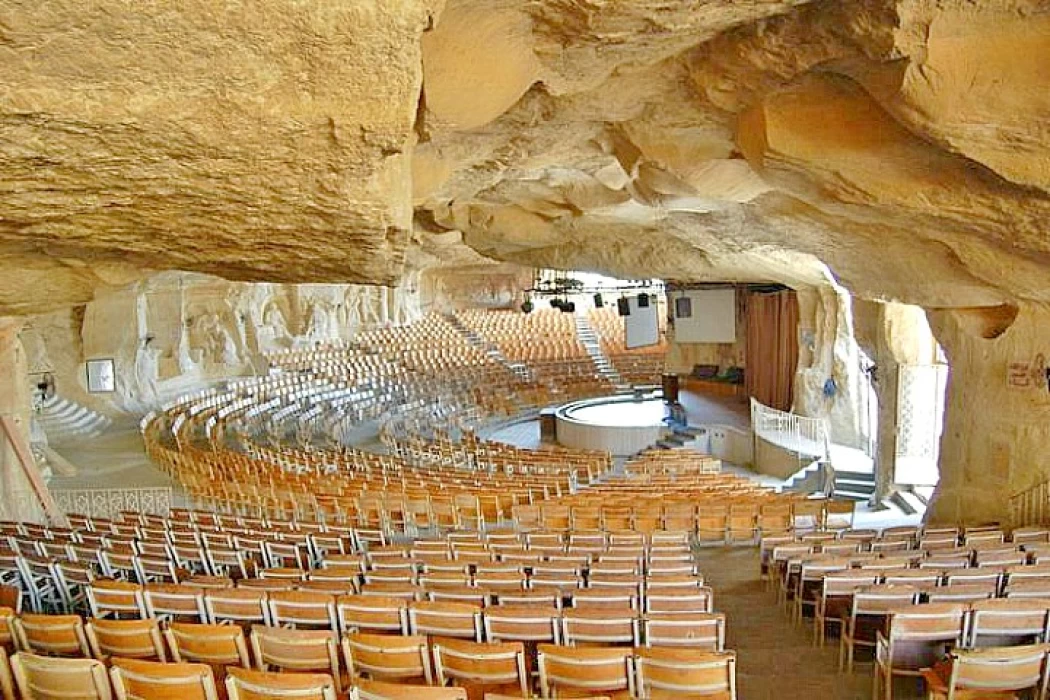
Kloster des Heiligen Simon Der Gerber
Kloster des Heiligen Simon Der Gerber
Sobald Sie das Gebiet des Mokattam-Berges betreten und sich dem Abagya-Gebiet nähern, werden Sie mit Ihren Augen zu einem der seltensten architektonischen Artefakte geführt, die im Herzen des Mokattam-Berges und eines der kreativen Zeichen des Berges geschnitzt wurden.
Der hohe Berg fügt sich in die unverwechselbare Architektur ein, in der das Kloster erbaut wurde, und wurde von einer großen Anzahl von Touristen auf der ganzen Welt zu einem Weltbesuchort.
St. Simon der Gerber war ein Handwerker, der im 10. Jahrhundert lebte. Sein Kloster gilt als eines der wichtigsten Dinge, die in Kairo zu tun sind. Es wird jedoch normalerweise nicht während der kurzen Reiserouten und Kairoer Tagestouren sowie der Höhlenkirche besucht Ihm gewidmet könnte nicht mehr für 10 dauern. In einer bereits vorhandenen Höhle und dem Hang, der zum Kloster führte, können 20.000 Menschen an einer zentralen Kanzel Platz finden.
Verschiedene Höhlen wurden ebenfalls zu getrennten Kirchenräumen geformt und alle miteinander verbunden, um einen massiven christlichen Komplex im Herzen der Müllstadt zu schaffen. Hunderttausende Menschen pilgern jedes Jahr zum Kloster. Hunderttausende Menschen pilgern jedes Jahr zum Kloster.
Die Hauptkirche dort ist nach der Jungfrau Maria und dem heiligen Simon benannt, um an die Geschichte der Eröffnung des Mokattam-Berges im November 979 zu erinnern, als Simon der Gerber ausgewählt wurde, um dieses Wunder zu vollenden.
Der Berg Mokattam liegt gegenüber der Zitadelle von Saladin.
Historikern zufolge war Ya'qub ibn Kulas jüdischer Herkunft, der Minister des Kalifen al-Mu'izz Ledin Ellah, zutiefst antichristlich, und der Kalif war ein Mann des Wissens und der Literatur.
Letzterer lud den Patriarchen der Kopten ein, in seiner Gegenwart die Juden in religiösen Fragen zu erörtern, und der Patriarch antwortete auf die Einladung in Begleitung von
Bischof Sawyros Ibn Al-Maqfa. Während der Diskussion beschuldigte Sawyerus die Juden der Unwissenheit und zitierte einen Vers aus dem Buch Jesaja, der besagt: "Der Stier kennt seinen Stock, und der Esel ist der Besitzer seines Besitzers. Israel weiß es nicht! Mein Volk versteht es nicht!" "" (Jesaja 1: 3).
Dies löste den Zorn von Ibn Kallas aus, der mit einem seiner Gefährten beschloss, den Christen zu antworten, indem er ein Loch in ihren Büchern jagte, und seine Forschung schloss einen Vers im Neuen Testament, in dem Christus seine Jünger ansprach: „Wenn Sie Glauben hätten Wie ein Senfkorn würden Sie sagen, dass dieser Berg von hier nach dort geht. Also bewegt er sich, und nichts ist für Sie nicht möglich. "(Matt 20:17).
Der Minister präsentierte diesen Vers dem Kalifen und bat ihn, die Christen zu zwingen, den Anspruch ihres Buches zu beweisen. Dies appellierte an den Kalifen, der den Berg östlich von Kairo loswerden wollte. Wenn sich die Christen andererseits der Erfüllung des evangelischen Verses entziehen würden, wäre dies ein Beweis für die Ungültigkeit ihrer Religion und ihres Glaubens.
Al-Moez schickte den Patriarchen, um ihn über seine Bitte zu informieren, drohte ihm, falls er mit schwerwiegenden Konsequenzen scheiterte, und gab ihm drei Tage Zeit, um dies umzusetzen. Die ganze Kirche des Landes fastete und betete in dieser Zeit.
Die religiöse Erzählung vervollständigt die Geschichte und spricht über das Erscheinen der Jungfrau Maria auf dem Patriarchen am dritten Morgen. Ich sagte ihm, er solle rausgehen, um einen Mann mit einem Glas Wasser zu sehen, der der Auserwählte sein würde, um das Wunder an seinen Händen zu vollenden. Nachdem Simon das Gebot der Jungfrau ausgeführt hatte, fand er den Kharaz und erzählte ihm, was passiert war.
Letzteres bat er den Patriarchen, an dem Tag, an dem der Berg bewegt werden sollte, unter den Menschen zu bleiben, und von dort aus betete er, während der Patriarch das Kreuzzeichen zeichnete. Dies geschah, sagte er, als ein großes Erdbeben auftrat und sich der Berg bewegte, bis die Sonne darunter keuchte. Danach entkam Al-Kharaz, damit niemand gelobt werden konnte.
Auf 2 Bühnen wurden die Jungfrau Maria und die St. Simon Kathedrale errichtet. Erstens war es nur eine riesige Kalksteinhöhle im Berg. Die 2. Etappe fand im November 1994 am Fest des heiligen Simon statt. Um den Altar herum wurden feste Sitze in Form eines Viertelkreis-Auditoriums für bis zu fünftausend Personen errichtet. Deshalb wurde es die größte Kirche im Kloster.
Eine andere erstaunliche Kirche im Kloster ist die St. Bola-Kirche, benannt nach St. Bola, dem ersten Pilger für Tugenden, die er besaß. Er lebte 70 Jahre in Höhlen und Einsamkeit, in denen er niemals ein menschliches Gesicht sah.
Die Kapellenhöhle wurde 1986 während der Bauarbeiten entdeckt, als ein riesiger Stein fiel, der eine Öffnung in der Decke der Höhle zeigte. Eine interessante Geschichte über diese Kirche fand im Januar 1992 statt, als sie durch ein Feuer gefährdet wurde, das durch einen elektrischen Funken verursacht wurde. Das Bild von Jesus Christus, das sich in der Kirche und im Altar ausdehnte, wurde durch keine Mittelwerte beschädigt, obwohl das gesamte Innere der Höhle beschädigt war.
Dann haben wir die Kirche der Markuskirche (benannt nach Markus, dem ersten Prediger, der als die erste Kirche in Afrika und Ägypten gilt) und den Gerber Simon.
Sie können viele interessante Dinge über ein besonderes Gebäude namens Baron Empain Palace entdecken. Er befindet sich in einer großen Stadt namens Kairo, die in einem Land namens Ägypten liegt.
A Hidden Gem in Cairo's Mokattam Hills .One of the most remarkable and beautiful historical places of worship is the Monastery of Saint Simon the Tanner, also known as the Cave Church, situated in the hilly, rocky Mokattam Hills of Cairo. Unlike the busy and crowded capital city of Egypt, this beautiful monastery does not only serve as a tranquil sacred space open to those who come in to seek the presence of God but rather possesses an exceptional view of walls sculpted into rocks forming the structure of the church. The very history of the place is almost more than ancient Coptic Christianity and the miraculous. For this reason, no matter how much in a hurry one is, a visit to this place is worth it for every religious lover wanting to explore Egypt’s religious mosaic.
The monastery is named after Saint Simon the Tanner, a Coptic saint from the 10th century who is most celebrated for a miracle during the rule of the Fatimid Caliph Al-Muizz. As per the Coptic tradition, it is said that during one of the reigns of the Copts, Al Muiz introduced a challenge to Pope Abram, the most senior leader of the Coptic Orthodoxy, to shift the Mokkatam mountain to illustrate that Christianity is true. After three days spent in prayers and fasting, Pope Abram had a vision of the virgin Mary, who asked him to look for Simon the Tanner. Simon, a simple leather craftsman who was very well connected with God, when the church gathered to pray, the mountain in question was raised, thus demonstrating the Christian religion to Al Muiz.
As a remembrance of this miracle, many centuries later, the large monastery compound in Mokattam was built in recognition of Saint Simon and the important event. At present, the monastery is also a monument to the Christian history of Egypt and the Christian context of the country.
The Monastery of Saint Simon the Tanner, which is located in the city of Cairo, is paradoxically quite remote. This monastery is located within Mokattam’s garbage city, wherein the Zabbaleen, are informal garbage cleaners of the city. The monastery, however, remains an island of peace amidst the turmoil. While the path to the monastery weaves through several narrow, twisting cores and squat buildings teeming with the city’s recycling activity, the view of the Cave Church’s gigantic rock-hewn altar is simply astounding.
The Monastery of Saint Simon the Tanner encloses an ensemble of several churches, each of exceptional interest: The most well-known and the one that leaves the greatest impression is The Cave Church, or, as it is more often referred to, The Church of Saint Simon the Tanner. This colossal area is hewn from the mountainside, making it the biggest church in the entire Middle East that can hold about 20,000 people. The inside of the cave is filled with religious images, paintings, and sculptures from the Holy Bible and the life of Saint Simon, which is all aglow with bright light coming from the rock ceilings. Above the cave, there are numerous cracks through which come rays of sunlight.
Within the compound, there are other notable churches such as:
The Church of Saint Mark: A compact but equally attractive church boasting soft stone carvings and quiet, contemplative areas for prayer and meditation.
The Church of Saint Bola: This church is also hewn from the rock and is cherished by tourists for its calm and peaceful interiors.
The Church of the Virgin Mary and St. Simon the Tanner: A congregation of faithful at a smaller church, where the churchgoers convene for daily masses and spiritual services.
Every church embodies a different spirit and embraces the beauty of nature along with the depth of spiritual culture.
The architecture of the Monastery of Saint Simon the Tanner is one of its most breathtaking features. The churches and spaces are not built conventionally but are hewed out of the rock of the Mokattam Hills. The use of natural, unprocessed limestone as the wall surfaces creates a rugged environment for the interior, allowing the guests to truly appreciate the ancient history of this place. This style of building also plays a part in enhancing the quality acoustic properties of the monastery, enabling the beautiful resonation of the Coptic liturgical hymns and chants all around the huge cave.
The outside view of the church complex is also exceptional. The corrugated grounds at the periphery of the monastery are embellished with high-relief sculptures and carvings that illustrate Biblical and Coptic cultural incidents. These high-stand carvings were done by a Polish sculptor, invariably hierarchy, thereby elevating the station of the site.
The Zabbaleen Connection
Over the last century, the Zabbaleen, a well-organized group of waste collectors or garbage collectors inhabiting the Mokattam region of Cairo, have had a very positive interaction with the Monastery of Saint Simon the Tanner. Most of the Zabbaleen are Copts, and like most communities in Egypt, they have suffered from troubles both social and economic. Nevertheless, a considerable part of this population has thrived in Garbage City through better integration of waste management and environmental services.
Though the purpose of the monastery transcends the physical boundary of the monastery, containing the Zabbaleen as it is, the monastery also offers hope and faith to these people. Some of the Zabbaleen assist in maintaining the monastery, and the place is important in their routine activity as a prayer and a meeting place. In addition to the monastery of Saint Simon the Tanner, a visit to the Zabbaleen's settlement reveals the extent to which their relentless work in recycling waste in Cairo went.
Religious significance and pilgrimage
The Monastery of Saint Simon the Tanner is a well-known place of pilgrimage for Coptic Christians not only in Egypt but also throughout the world. Many pilgrims primarily come to pray and meditate on the life and miracles of St. Simon. They seek inner healing and divine connection. The church also conducts regular services such as mass and other religious activities besides of the memorial services for Saint Simon, who is remembered annually on the 26th day of November.







